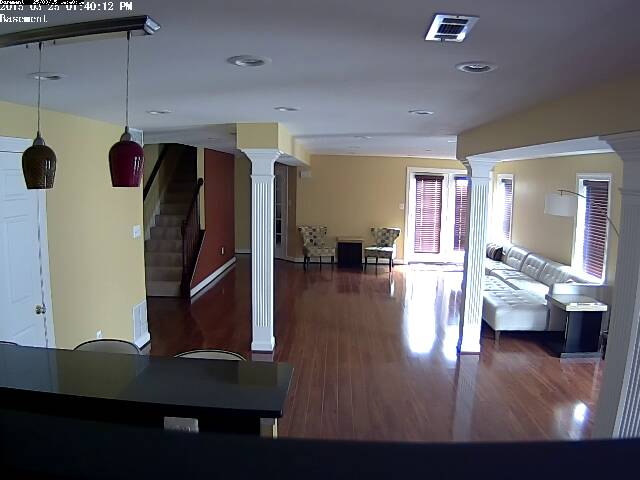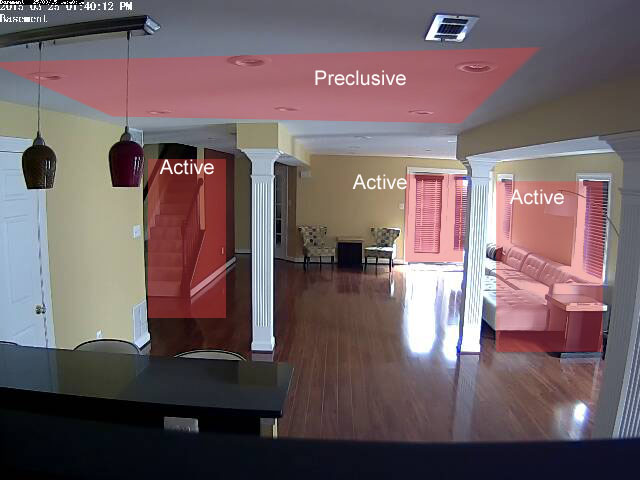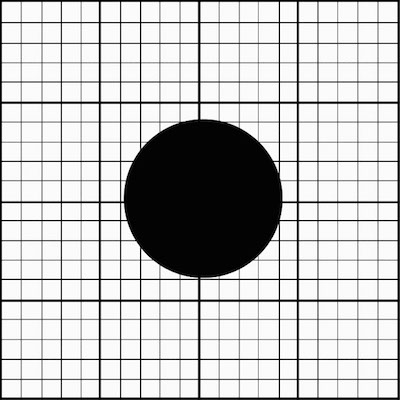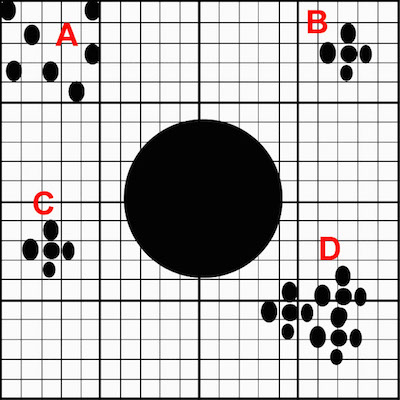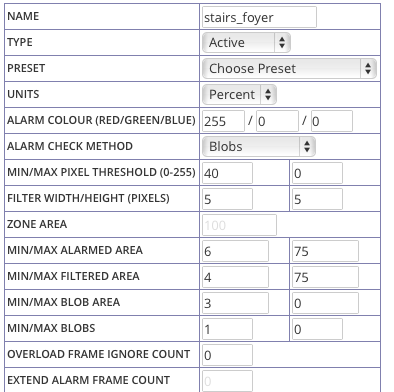Difference between revisions of "Understanding ZoneMinder's Zoning system for Dummies"
| Line 80: | Line 80: | ||
[[File:Stairs foyer.png]] | [[File:Stairs foyer.png]] | ||
Lets see how ZM will use these values: | |||
* Use the "blob" method to detect movement (which means first use Alarmed pixels, then use Filtered Pixels, then use Blob) | |||
ZM's motion detection algorithm for this zone: | |||
#Set A = full zone pixels | |||
#(Min/Max Pixel Thres) In the *Full* area defined by the zone, check if there are any pixels that have have a 40 count difference in pixel color from a previous. Assign to Set B. If Set B = null, don't raise alarm, don't proceed with rest. | |||
#(Min/Max Alarmed Area) check if Set B is at least 6% of Set A and not more than 75% of Set A. If Set B does not fall in this range, don't raise alarm, don't proceed with rest. | |||
#(Filter Width/Height) In the set of pixels (Set B) that are different in color value of 40, check if there are pixels that are surrounded by 5 more pixels around them that are also different in color value of 40. Assign to Set C. If Set C = null, don't raise alarm, don't proceed with rest | |||
#(Min/Max Filtered Area) check if Set C forms at least 4% of Set A but no more than 75% of Set A. If Set C does not fall in this range, don't raise alarm, don't proceed with rest | |||
#(Min/Max Blob Area) use Blob logic on Set C to figure out how many Blobs are there. A blob that is at least 4% in size of Set A (full pixels) is considered a blob. Assign this to Set D. | |||
#(Min/Max Blobs) - If the # of blobs in Set D is less than 1, don't raise an alarm, don't proceed with rest | |||
'''# Raise Alarm!''' | |||
Revision as of 17:36, 25 March 2015
Background
ZoneMinder has a powerful zone detection system using which you can modify how sensitive, precise, accurate your motion alarms are. The official ZM documentation does a good job of describing all the concepts here. However, you will see gobs of posts in the forum about people complaining that ZM logs all sorts of events (ahem, as did I), ZM's detection is rubbish and in-camera is better (ahem, as did I) and what not. But once you get the concept, its incredibly powerful.
So instead of giving you a theoretical explanation, lets walk through a live use-case. (Credit: user kkroft helped a lot in me getting a hang of things here. You should also read his earlier explanation here)
Some concepts
Let's take a look at this area below. Lets suppose you want to trigger motion if someone tries to break into your basement. Does it make sense you monitor the full area (pillars/walls/floor)? Probably not. If someone were to break in, they'd break in from some door, some window, or maybe break in from upstairs and climb down the stairs. So doesn't it make more sense to monitor these areas specifically? I think so. So the first 'common sense' logic is delete the default zone that ZM creates for each monitor (which is called All). Monitoring every part of your image may make sense if you are monitoring and outdoor lawn, for example. Not here
Defining the zone areas
So given the explanation above, how about we define zones where motion matters? Any zone you define as "active" is what ZoneMinder will analyze for motion. Ignore the 'preclusive for now'. So lets look at the image below. I've defined polygons around places that are the "entry points"
Okay, now how do I specify the sensitivity of the zones?
ZoneMinder has pre-sets. We live in a world of pre-sets. I bet you want to select "Best and highly sensitive" don't you? DON'T. Not because that setting is nonsense, but because you should understand some concepts first.
Core Concepts
The ZM wiki I pointed to earlier does a great job of explaining different methods. At the cost of repeating what has already been said, its important to note:
- ZM does NOT understand objects. It only understands pixel colors. So if you are monitoring a camera that is producing a 1280x960 32bit color depth image, as far as ZM is concerned, it is getting an array of 1280*960*32 bits of data to analyze and compare a previous frame and based on 'color differences' between frame X-1 and X along with some algorithms it applies in addition to color differences, it tries and guesses if objects (in ZM speak, a specific pattern of pixels) have come up that were not there previously.
- ZM has 3 methods of detection: Alarmed Pixels, Filtered Pixels and Blobs. Here is a visual explanation of their differences
The first image is a 20x20 grid. Let's assume this is a zone. And the black circle is some object in this grid. The second image shows the next frame of that image, where new 'objects' have appeared, or in ZM's view 'new sets of pixel patterns'
Now let's talk about Alarmed Pixels, Filtered Pixels and Blobs
Alarmed Pixels
Alarmed pixels only deals with pixels changes. If we use the alarmed pixel method and specify a minimum of "5 pixel" changes (lets forget max for now), then all the new pixels of set A + B + C + D will count as alarmed pixels and the total alarmed pixel count will be A+B+C+D
Filtered Pixels
Now let's assume we used Filtered pixels and set it to 2x2 pixels. The in addition to computing the alarmed pixels (A+B+C+D), it will also count how many of these sets have at least 2 pixels around them that are also alarmed pixels. This will result in B+C+D (set A will be discarded as they don't have any pixels surrounded by at least 2 pixels that have changed color from the prev. frame)
Blob Pixels
Now lets assume we used Blob and said a blob needs to be at least 10 pixels. Then what it will do is based on the set computed by Filtered pixels, which is B+C+D it will look for contiguous blobs of 10 pixels and that only means D
So, in Alarmed pixels any of A, B, C or D would raise an alarm In filtered pixel mode, only B, C or D would raise an alarm In blob mode only D would raise an alarm
Okay, that was a simple explanation. And I did not cover more details on min/max. But I hope you get the core idea..
Yawn. Forget the theory. Let's get back to your basement image
Okay, back to my basement and my 3 zones.
Which detection type should I use?
I personally feel to detect "humans", blob is the best. As I described above, it combines Alarm + Filtered + ensures that the pixel differences are contiguous and then does an algorithmic analysis to see if it forms 'blobs'
Pixels or percents?
What makes more sense to you? "Raise an alarm if 178pixels are changed" or "Raise an alarm if more than 20% of my zone has changed?". To me, the latter makes much more sense. So I've always used percents
Right percents. But what values?
It helps to think visually here. Let's go back to the zones I drew of my basement and try and visually place how a person and a pet would look in each zone. Here is a take:
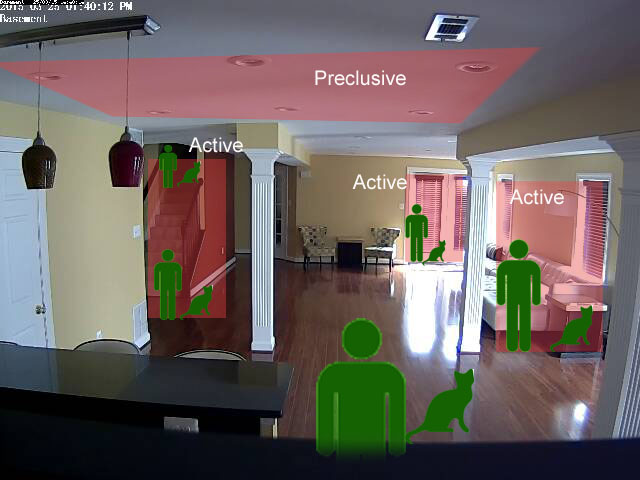
- Zones and Depths: One of the learning for me was that don't make zones cover a lot of depth as far as the camera lens goes. Why? Well take a look at the image above. As a person or a pet walks away or towards the camera, it gets significantly bigger or smaller (right, that was not rocket science, but sometimes commonsense 101 helps)
- Percent vs. Pixels: Back to my previous point -if you specify alarmed areas in pixels, in addition to being able to visualize better (at least for me) the added advantage is the setting scales as zone sizes changes. For example the % of space the person takes in my far end "Door" zone is quite similar to the % of space the person takes in my couch area (in other words, both the zone and person have scaled up in size, so relative % is still the same)
- So having said all of this, this is what my zone definition for the "stairs area" looks like:
Lets see how ZM will use these values:
- Use the "blob" method to detect movement (which means first use Alarmed pixels, then use Filtered Pixels, then use Blob)
ZM's motion detection algorithm for this zone:
- Set A = full zone pixels
- (Min/Max Pixel Thres) In the *Full* area defined by the zone, check if there are any pixels that have have a 40 count difference in pixel color from a previous. Assign to Set B. If Set B = null, don't raise alarm, don't proceed with rest.
- (Min/Max Alarmed Area) check if Set B is at least 6% of Set A and not more than 75% of Set A. If Set B does not fall in this range, don't raise alarm, don't proceed with rest.
- (Filter Width/Height) In the set of pixels (Set B) that are different in color value of 40, check if there are pixels that are surrounded by 5 more pixels around them that are also different in color value of 40. Assign to Set C. If Set C = null, don't raise alarm, don't proceed with rest
- (Min/Max Filtered Area) check if Set C forms at least 4% of Set A but no more than 75% of Set A. If Set C does not fall in this range, don't raise alarm, don't proceed with rest
- (Min/Max Blob Area) use Blob logic on Set C to figure out how many Blobs are there. A blob that is at least 4% in size of Set A (full pixels) is considered a blob. Assign this to Set D.
- (Min/Max Blobs) - If the # of blobs in Set D is less than 1, don't raise an alarm, don't proceed with rest
# Raise Alarm!
